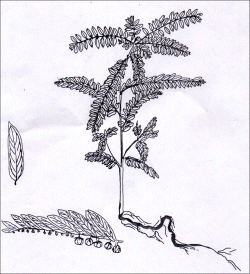
|

|
PHYLLANTHUS URINARIA L. - SHATTERSTONE Common name
Common nameChanca piedra, shatterstone, meniran, stone breaker, quebra pedra, zhen chu cao, ye xia zhu, chamber bitter, kilanelli, leafflower, komikansou. Family Euphorbiaceae (Spurge family). Overview Shatterstone is a small tropical annual herb growing up to 2 feet tall. Along the erect, red stem are equally set small green, oblong feathered leaves. It has greenish white flowers. A very small wart-like fruit, greenish-red, is underneath every pair of the feathered leaves. When the plant is picked the feathery leaves fold in, completely closing themselves. It is a common weed in Suriname and closely related in appearance and phytochemical structure to two other weeds, also common in this country: Phyllanthus amarus and phyllanthus niruri. The difference between Phyllanthus urinaria and Phyllanthus amarus. Amarus and niruri: urinaria has larger leaves than the latter and the fruit of p. urinaria is wart-like. Also the stem is red and the plant as the whole is bigger. The plant is used for several conditions such as blennorrhagia (gonorrhea), diabetes, dysentery, flu, tumors, jaundice (the yellow color of the skin and whites of the eyes caused by excess bilirubin in the blood), vaginitis (swelling, itching, burning or infection in the vagina), against headache, fever, conjuntivitis (pinkeye or bloodshot eyes), menstrual disorders and dyspepsia (pain or an uncomfortable feeling in the upper middle part of the stomach). Meniran has proven to be antihepatotoxic, antiviral, antibacterial and hypoglycemic; also used for the elimination of kidney- and gallstones. It is excellent in treating liver- and kidney ailments; used extensively for detoxification. Suriname's traditional medicine It is used against colic, and as an effective remedy to eliminate gall - and kidney stones, urinary tract infection (UTI), bladder inflammation and for other kidney and liver problems in general such as acute - and chronic Hepatitis B. For more details on the phytochemistry and pharmacology of this cleansing herb, go to "Medicine from nature" page. Pharmacology The primary action of shatterstone is on the liver; it acts by the inhibition of DNA polymerase on the hepatitis B virus. The enzyme DNA polymerase is needed for the virus to reproduce. Several studies suggest that Phyllanthus urinaria works better than the related species p. amarus, p. debilis and p. niruri in the treatment of hepatitis B. An equally important action is the use against kidney stones (renal calculi), urinary tract- and bladder infections. In preliminary research in animals, extracts of Phyllanthus plants have shown promising results in pain relief. The mechanism seems to be that this is reached by decreasing inflammation. Dosage Two - to tree cups (1 - 2 teaspoon / cup) of tea, daily for two months. Side effects No side effects have been reported. For more information go to: APPLICATION AND DOSAGE page. Visit also our CHOLESTEROL- , DIABETES- , GOUT- , HYPERTENSION- , KIDNEY DETOXIFICATION- , LIVER DETOXIFICATION- and TINCTURE pages. Hardiness USDA zone 8 - 11. In summer: zone 6 - 11. Propagation Seeds. Culture Full sun / partial shade, sandy loam soil. |
For the right freight rate, shipping charges, conditions and delivery service, please visit our Webstore page! |